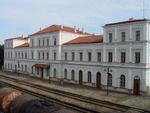 L001.jpg (128190 bytes)
L001.jpg (128190 bytes)|
The Railfaneurope.net Picture Gallery
Directory: /pix/lv/station/Liepaja
Last update: Sat Jul 20 20:31:06 CEST 2019
|
|
Liepaja station, Latvia. 30/08/2006
Photo by Paul Brunowlensky |
|
Liepaja station building, Latvia. 31/08/2006
Photo by Paul Brunowlensky |
|
LDZ - Latvia Only one passenger train pair per week(!) uses the beautiful railway station of Liepaja. It arrives on friday from Riga, and departs again on sunday. Liepaja, 21-06-2019 Digital photo by Marco van Uden |
|
Liepaja, Latvia's third biggest town, situated in Lower Courland 220 km from Riga on the Baltic coast, is the industrial city with an ice-free harbour and a huge metallurgical complex (Liepajas metalurgs). The second half of the 19th century saw the rapid expansion of industry and industrial related activities. Having direct railway connection with the fertile parts of southern and south-eastern Russia, Liepaja (Libau, Lipawa) has become the modern port for foreign trade on the Baltic specialized in exporting Russian grain. Before WWI Liepaja was also the biggest Russian emigration port. It had a regular transatlantic shipping service to New York and Halifax, between 1906 and 1913 ca. 330,000 emigrants from Eastern Europe passed through the city on their way to the New World and to the New Life. At the same time Kara Osta (War Port) was built as a naval base for the Russian tsar, later used by the Soviet Navy. As a result of this prosperity, the Liepaja's population, which was only 9,970 in 1863, increased to 64,489 in 1897 and to over 100,000 in 1914 (more than today). Yet in 1863, nearly 80% of the inhabitants were Germans, 16% Latvians and 3% Russians. Destroyed during WWII and then rebuilt, Liepaja was in the Soviet period a completely closed city, Westerners were not allowed to come here and even nearby villagers needed a special permit to enter it. Today the town has a population of approximately 85,000, about half of it is Russian-speaking. With the area of 60 sq km, Liepaja is sandwiched between coastal Lake of Liepaja (Liepajas ezers) and the Baltic Sea. The city can be divided into two parts: New Liepaja (Jaunliepaja) and Old Liepaja (Vecliepaja) which are separated with the navigable Trade Canal (Tirdzniecibas kanals) flowing from the Lake of Liepaja to the sea. The bus and railway stations are together right at the end of Jaunliepaja, north of the city centre, about 20 minutes' walk from Tram Bridge (Tramvaja tilts). Two trains daily run to Riga stopping at Skrunda, Saldus, and Jelgava. Departures at 6.10 am and 4.55 pm, arrivals to Riga at 10.45 am and 9.30 pm. The train service to Ventspils, interesting not only for railfans, has not existed since last year. July 1999. jaroslaw swajdo www.swajdo.travel.pl |